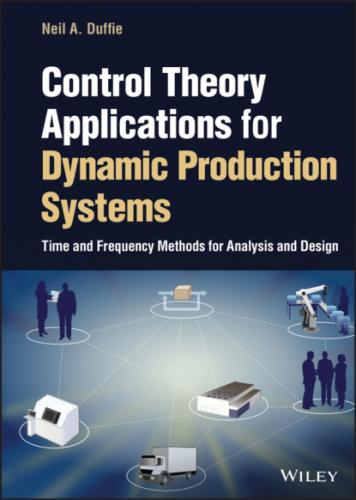Control Theory Applications for Dynamic Production Systems
Time and Frequency Methods for Analysis and Design
Neil A. DuffieUniversity of WisconsinMadison, Wisconsin
This edition first published 2022
© 2022 John Wiley & Sons, Inc.
All rights reserved. No part of this publication may be reproduced, stored in a retrieval system, or transmitted, in any form or by any means, electronic, mechanical, photocopying, recording or otherwise, except as permitted by law. Advice on how to obtain permission to reuse material from this title is available at http://www.wiley.com/go/permissions.
The right of Neil A. Duffie to be identified as the author of this work has been asserted in accordance with law.
Registered Office
John Wiley & Sons, Inc., 111 River Street, Hoboken, NJ 07030, USA
Editorial Office
111 River Street, Hoboken, NJ 07030, USA
For details of our global editorial offices, customer services, and more information about Wiley products visit us at www.wiley.com.
Wiley also publishes its books in a variety of electronic formats and by print-on-demand. Some content that appears in standard print versions of this book may not be available in other formats.
Limit of Liability/Disclaimer of Warranty
The contents of this work are intended to further general scientific research, understanding, and discussion only and are not intended and should not be relied upon as recommending or promoting scientific method, diagnosis, or treatment by physicians for any particular patient. In view of ongoing research, equipment modifications, changes in governmental regulations, and the constant flow of information relating to the use of medicines, equipment, and devices, the reader is urged to review and evaluate the information provided in the package insert or instructions for each medicine, equipment, or device for, among other things, any changes in the instructions or indication of usage and for added warnings and precautions. While the publisher and authors have used their best efforts in preparing this work, they make no representations or warranties with respect to the accuracy or completeness of the contents of this work and specifically disclaim all warranties, including without limitation any implied warranties of merchantability or fitness for a particular purpose. No warranty may be created or extended by sales representatives, written sales materials or promotional statements for this work. The fact that an organization, website, or product is referred to in this work as a citation and/or potential source of further information does not mean that the publisher and authors endorse the information or services the organization, website, or product may provide or recommendations it may make. This work is sold with the understanding that the publisher is not engaged in rendering professional services. The advice and strategies contained herein may not be suitable for your situation. You should consult with a specialist where appropriate. Further, readers should be aware that websites listed in this work may have changed or disappeared between when this work was written and when it is read. Neither the publisher nor authors shall be liable for any loss of profit or any other commercial damages, including but not limited to special, incidental, consequential, or other damages.
A catalogue record for this book is available from the Library of Congress
Hardback ISBN: 9781119862833; ePub ISBN: 9781119862857; ePDF ISBN: 9781119862840; Obook ISBN: 9781119862864
Cover Image: Courtesy of John Miller, grayjaygraphics.com
Cover Design: Wiley
Set in 9.5/12pt and STIXTwoText by Integra Software Services Pvt. Ltd, Pondicherry, India
To Hans-Peter Wiendahl (1938–2019)
Contents
1 Cover
5 Preface
7 1 Introduction1.1 Control System Engineering Software
8 2 Continuous-Time and Discrete-Time Modeling of Production Systems2.1 Continuous-Time Models of Components of Production Systems2.2 Discrete-Time Models of Components of Production Systems2.3 Delay2.4 Model Linearization2.4.1 Linearization Using Taylor Series Expansion – One Independent Variable2.4.2 Linearization Using Taylor Series Expansion – Multiple Independent Variables2.4.3 Piecewise Approximation2.5 Summary
9 3 Transfer Functions and Block Diagrams3.1 Laplace Transform3.2 Properties of the Laplace Transform3.2.1 Laplace Transform of a Function of Time Multiplied by a Constant3.2.2 Laplace Transform of the Sum of Two Functions of Time3.2.3 Laplace Transform of the First Derivative of a Function of Time3.2.4 Laplace Transform of Higher Derivatives of a Function of Time Function3.2.5 Laplace Transform of Function with Time Delay3.3 Continuous-Time Transfer Functions3.4 Z Transform3.5 Properties of the Z Transform3.5.1 Z Transform of a Sequence Multiplied by a Constant3.5.2 Z Transform of the Sum of Two Sequences3.5.3 Z Transform of Time Delay dT3.5.4 Z Transform of a Difference Equation3.6 Discrete-Time Transfer Functions3.7 Block Diagrams3.8 Transfer Function Algebra3.8.1 Series Relationships3.8.2 Parallel Relationships3.8.3 Closed-Loop Relationships3.8.4 Transfer Functions of Production Systems with Multiple Inputs and Outputs3.8.5 Matrices of Transfer Functions3.8.6 Factors of Transfer Function Numerator and Denominator3.8.7 Canceling Common Factors in a Transfer Function3.8.8 Padé Approximation of Continuous-Time Delay3.8.9 Absorption of Discrete Time Delay3.9 Production Systems with Continuous-Time and Discrete-Time Components3.9.1 Transfer Function of a Zero-Order Hold (ZOH)3.9.2 Discrete-Time Transfer Function Representing Continuous-Time Components Preceded by a Hold and Followed by a Sampler3.10 Potential Problems in Numerical Computations Using Transfer Functions3.11 Summary
10 4 Fundamental Dynamic Characteristics and Time Response4.1 Obtaining Fundamental Dynamic Characteristics from Transfer Functions4.1.1 Characteristic Equation4.1.2 Fundamental Continuous-Time Dynamic Characteristics4.1.3 Continuous-Time Stability Criterion4.1.4 Fundamental Discrete-Time Dynamic Characteristics4.1.5 Discrete-Time Stability Criterion4.2 Characteristics of Time Response4.2.1 Calculation of Time Response4.2.2 Step Response Characteristics4.3 Summary
